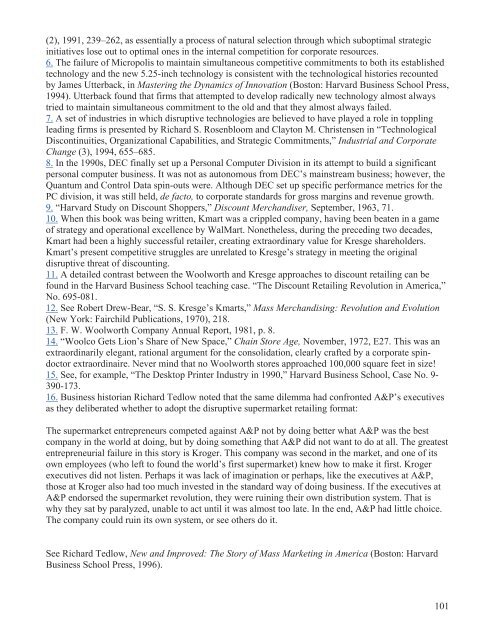PRUEBAS
PRUEBAS
PRUEBAS
You also want an ePaper? Increase the reach of your titles
YUMPU automatically turns print PDFs into web optimized ePapers that Google loves.
(2), 1991, 239–262, as essentially a process of natural selection through which suboptimal strategicinitiatives lose out to optimal ones in the internal competition for corporate resources.6. The failure of Micropolis to maintain simultaneous competitive commitments to both its establishedtechnology and the new 5.25-inch technology is consistent with the technological histories recountedby James Utterback, in Mastering the Dynamics of Innovation (Boston: Harvard Business School Press,1994). Utterback found that firms that attempted to develop radically new technology almost alwaystried to maintain simultaneous commitment to the old and that they almost always failed.7. A set of industries in which disruptive technologies are believed to have played a role in topplingleading firms is presented by Richard S. Rosenbloom and Clayton M. Christensen in “TechnologicalDiscontinuities, Organizational Capabilities, and Strategic Commitments,” Industrial and CorporateChange (3), 1994, 655–685.8. In the 1990s, DEC finally set up a Personal Computer Division in its attempt to build a significantpersonal computer business. It was not as autonomous from DEC’s mainstream business; however, theQuantum and Control Data spin-outs were. Although DEC set up specific performance metrics for thePC division, it was still held, de facto, to corporate standards for gross margins and revenue growth.9. “Harvard Study on Discount Shoppers,” Discount Merchandiser, September, 1963, 71.10. When this book was being written, Kmart was a crippled company, having been beaten in a gameof strategy and operational excellence by WalMart. Nonetheless, during the preceding two decades,Kmart had been a highly successful retailer, creating extraordinary value for Kresge shareholders.Kmart’s present competitive struggles are unrelated to Kresge’s strategy in meeting the originaldisruptive threat of discounting.11. A detailed contrast between the Woolworth and Kresge approaches to discount retailing can befound in the Harvard Business School teaching case. “The Discount Retailing Revolution in America,”No. 695-081.12. See Robert Drew-Bear, “S. S. Kresge’s Kmarts,” Mass Merchandising: Revolution and Evolution(New York: Fairchild Publications, 1970), 218.13. F. W. Woolworth Company Annual Report, 1981, p. 8.14. “Woolco Gets Lion’s Share of New Space,” Chain Store Age, November, 1972, E27. This was anextraordinarily elegant, rational argument for the consolidation, clearly crafted by a corporate spindoctorextraordinaire. Never mind that no Woolworth stores approached 100,000 square feet in size!15. See, for example, “The Desktop Printer Industry in 1990,” Harvard Business School, Case No. 9-390-173.16. Business historian Richard Tedlow noted that the same dilemma had confronted A&P’s executivesas they deliberated whether to adopt the disruptive supermarket retailing format:The supermarket entrepreneurs competed against A&P not by doing better what A&P was the bestcompany in the world at doing, but by doing something that A&P did not want to do at all. The greatestentrepreneurial failure in this story is Kroger. This company was second in the market, and one of itsown employees (who left to found the world’s first supermarket) knew how to make it first. Krogerexecutives did not listen. Perhaps it was lack of imagination or perhaps, like the executives at A&P,those at Kroger also had too much invested in the standard way of doing business. If the executives atA&P endorsed the supermarket revolution, they were ruining their own distribution system. That iswhy they sat by paralyzed, unable to act until it was almost too late. In the end, A&P had little choice.The company could ruin its own system, or see others do it.See Richard Tedlow, New and Improved: The Story of Mass Marketing in America (Boston: HarvardBusiness School Press, 1996).101


